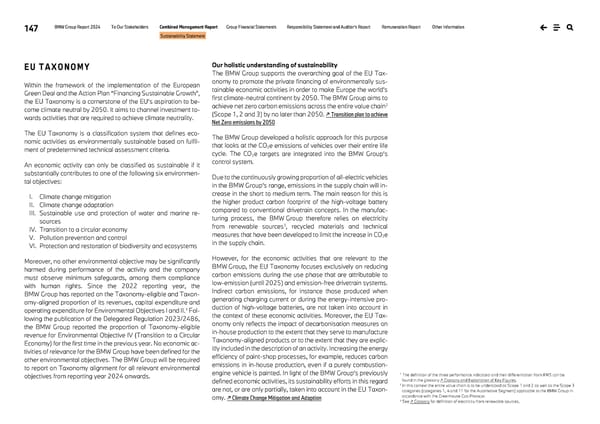147 BMW Group Report 2024 To Our Stakeholders Combined Management Report Group Financial Statements Responsibility Statement and Auditor’s Report Remuneration Report Other Information Sustainability Statement EU TAXONOMY Within the framework of the implementation of the European Green Deal and the Action Plan “Financing Sustainable Growth”, the EU Taxonomy is a cornerstone of the EU’s aspiration to be- come climate neutral by 2050. It aims to channel investment to- wards activities that are required to achieve climate neutrality. The EU Taxonomy is a classification system that defines eco- nomic activities as environmentally sustainable based on fulfil- ment of predetermined technical assessment criteria. An economic activity can only be classified as sustainable if it substantially contributes to one of the following six environmen- tal objectives: I. Climate change mitigation II. Climate change adaptation III. Sustainable use and protection of water and marine re- sources IV. Transition to a circular economy V. Pollution prevention and control VI. Protection and restoration of biodiversity and ecosystems Moreover, no other environmental objective may be significantly harmed during performance of the activity and the company must observe minimum safeguards, among them compliance with human rights. Since the 2022 reporting year, the BMW Group has reported on the Taxonomy-eligible and Taxon- omy-aligned proportion of its revenues, capital expenditure and operating expenditure for Environmental Objectives I and II.1 Fol- lowing the publication of the Delegated Regulation 2023/2486, the BMW Group reported the proportion of Taxonomy-eligible revenue for Environmental Objective IV (Transition to a Circular Economy) for the first time in the previous year. No economic ac- tivities of relevance for the BMW Group have been defined for the other environmental objectives. The BMW Group will be required to report on Taxonomy alignment for all relevant environmental objectives from reporting year 2024 onwards. Our holistic understanding of sustainability The BMW Group supports the overarching goal of the EU Tax- onomy to promote the private financing of environmentally sus- tainable economic activities in order to make Europe the world’s first climate-neutral continent by 2050. The BMW Group aims to achieve net zero carbon emissions across the entire value chain2 (Scope 1, 2 and 3) by no later than 2050. ↗ Transition plan to achieve Net Zero emissions by 2050 The BMW Group developed a holistic approach for this purpose that looks at the CO2e emissions of vehicles over their entire life cycle. The CO2e targets are integrated into the BMW Group’s control system. Due to the continuously growing proportion of all-electric vehicles in the BMW Group’s range, emissions in the supply chain will in- crease in the short to medium term. The main reason for this is the higher product carbon footprint of the high-voltage battery compared to conventional drivetrain concepts. In the manufac- turing process, the BMW Group therefore relies on electricity from renewable sources3, recycled materials and technical measures that have been developed to limit the increase in CO2e in the supply chain. However, for the economic activities that are relevant to the BMW Group, the EU Taxonomy focuses exclusively on reducing carbon emissions during the use phase that are attributable to low-emission (until 2025) and emission-free drivetrain systems. Indirect carbon emissions, for instance those produced when generating charging current or during the energy-intensive pro- duction of high-voltage batteries, are not taken into account in the context of these economic activities. Moreover, the EU Tax- onomy only reflects the impact of decarbonisation measures on in-house production to the extent that they serve to manufacture Taxonomy-aligned products or to the extent that they are explic- itly included in the description of an activity. Increasing the energy efficiency of paint-shop processes, for example, reduces carbon emissions in in-house production, even if a purely combustion- engine vehicle is painted. In light of the BMW Group’s previously defined economic activities, its sustainability efforts in this regard are not, or are only partially, taken into account in the EU Taxon- omy. ↗ Climate Change Mitigation and Adaption 1 The definition of the three performance indicators and their differentiation from IFRS can be found in the glossary ↗ Glossary and Explanation of Key Figures. 2 In this context the entire value chain is to be understood as Scope 1 and 2 as well as the Scope 3 categories (categories 1, 4 and 11 for the Automotive Segment) applicable to the BMW Group in accordance with the Greenhouse Gas Protocol. 3 See ↗ Glossary for definition of electricity from renewable sources.
 BMW Group Report 2024 Page 146 Page 148
BMW Group Report 2024 Page 146 Page 148